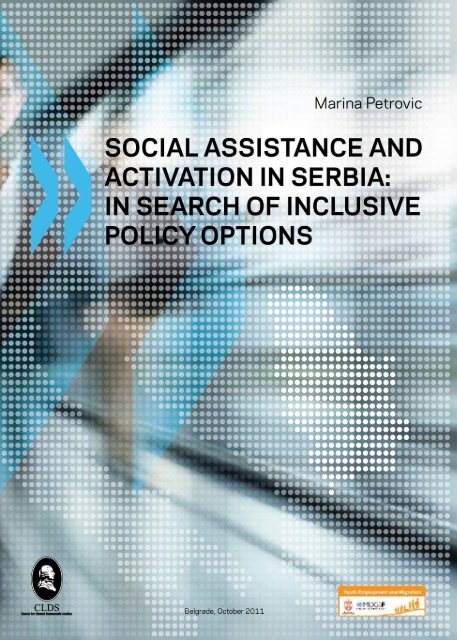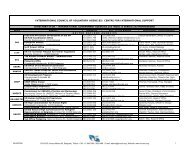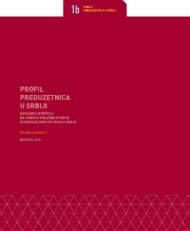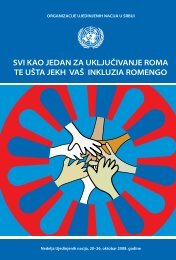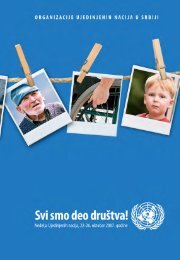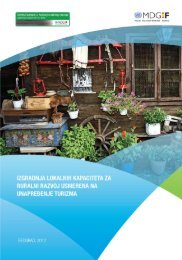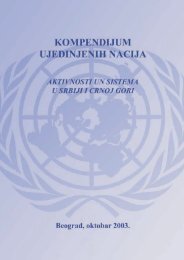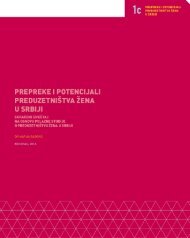Download - United Nations in Serbia
Download - United Nations in Serbia
Download - United Nations in Serbia
- No tags were found...
You also want an ePaper? Increase the reach of your titles
YUMPU automatically turns print PDFs into web optimized ePapers that Google loves.
ACKNOWLEDGEMENTSThis report was prepared by the Center for Liberal-Democratic Studies (CLDS) forthe Jo<strong>in</strong>t Programme Support to National Efforts for the Promotion of Youth Employmentand Management of Migration <strong>in</strong> <strong>Serbia</strong>, f<strong>in</strong>anced by the MDG AchievementFund. The research team worked under the leadership of Gordana Matkovic.The assistance of the Statistical Office of the Republic of <strong>Serbia</strong> (RSO), and <strong>in</strong> particularof Vladan Bozanic, <strong>in</strong> the data analysis is gratefully acknowledged.Thanks go also to Dragana Marjanovic and Valli Corbanese of the InternationalLabour Office for their comments on the first draft of the report.3
ContentsExecutive summary 6Introduction 71. Data and methodology 92. Ma<strong>in</strong> characteristics of the surveyed population 103. F<strong>in</strong>ancial social assistance and employment record 144. Job search and return to education 185. Referrals 246. Is activation of FSA beneficiaries possible <strong>in</strong> <strong>Serbia</strong>? 277. Identification of groups with greatest activation potential 298. Towards more <strong>in</strong>clusive policy options 31References 35Statistical Annex 364
List of Tables, Figures and BoxesTable 1. Ma<strong>in</strong> characteristics of FSA recipientsTable 2. Reasons for los<strong>in</strong>g the job (FSA beneficiaries, %)Table 3. FSA recipients opt<strong>in</strong>g to work rather than rema<strong>in</strong> on benefits (%)Table 4. Reasons for not look<strong>in</strong>g for a job (Beneficiaries registered withthe NES),%Table 5. Ma<strong>in</strong> reasons for not return<strong>in</strong>g to school (%)Table 6. Ma<strong>in</strong> reasons for not participat<strong>in</strong>g to tra<strong>in</strong><strong>in</strong>g programmes (%)Table 7. Selected <strong>in</strong>dicators to monitor activation processesFigure 1. FSA and other social transfers (prior month) %Figure 2. Ma<strong>in</strong> reasons for opt<strong>in</strong>g to work (%)Figure 3. Ma<strong>in</strong> obstacles to work (%)Figure 4. Will<strong>in</strong>gness to return to education or participate to a tra<strong>in</strong><strong>in</strong>gprogramme (%)Figure 5. Will<strong>in</strong>gness to return to education/participate to tra<strong>in</strong><strong>in</strong>g(with conditionality) %Figure 6. Referrals between employment and social services (% )Figure 7. Referrals to education and tra<strong>in</strong><strong>in</strong>g (%)Figure 8. Subjective assessment of support received (%)Box 1. Ma<strong>in</strong> FSA provisions <strong>in</strong>troduced by the new Law on Social WelfareBox 2. Stylized facts about young FSA recipients (15-29 years old)Box 3. Public works <strong>in</strong> <strong>Serbia</strong>Box 4. Activation policies target<strong>in</strong>g young FSA recipients (15-29)5
Executive SummaryThe aim of this report is to offer a basel<strong>in</strong>e for the assessment of the effects of thenew Law on Social Welfare adopted by the Government of <strong>Serbia</strong> <strong>in</strong> April 2011. Thedata stems from an ad hoc survey conducted among the recipients of f<strong>in</strong>ancialsocial assistance (FSA) geared to identify their labour market status, educational atta<strong>in</strong>ment,job search activities and access to multi-agency referral system.Over two thirds of FSA recipients had atta<strong>in</strong>ed primary education or less at the timeof the survey, which is significantly lower than the average educational atta<strong>in</strong>mentof the <strong>Serbia</strong>n population. Only 3 percent of respondents reported to be employed,mostly <strong>in</strong> the <strong>in</strong>formal economy. Over 76 percent of all FSA recipients were registeredas unemployed with the National Employment Service (NES), but only 41 percentwere look<strong>in</strong>g for a job <strong>in</strong> the four weeks prior to the survey, with young peoplebe<strong>in</strong>g the most active of all. The ma<strong>in</strong> reasons for not actively search<strong>in</strong>g for a jobwere primarily poor health and disability, care responsibilities and discouragement.The survey data suggest that most of the potential for activation lies with the youngerpopulation (15-29). Young people are more keen to return to ma<strong>in</strong>streamed formaleducation or participate to tra<strong>in</strong><strong>in</strong>g programmes compared to other groups ofbenefit recipients. However, when conditionality is factored <strong>in</strong>to the entitlement tobenefits, perceptions about education, tra<strong>in</strong><strong>in</strong>g and employment shift considerably.Referrals between social and employment services cover a negligible share of recipients,with referrals from social and employment services to formal educationbe<strong>in</strong>g slightly more common.The results of the research po<strong>in</strong>t to a social assistance system that encourageswelfare dependency. The only activation strategy currently available, e.g. the publicworks programme, has shown positive results <strong>in</strong> <strong>in</strong>creas<strong>in</strong>g beneficiaries’ employabilityand work read<strong>in</strong>ess, but only for FSA recipients belong<strong>in</strong>g to the age groups30 to 49 and 50 to 64 years old. This suggests that a different activation strategyneeds to be deployed to target young beneficiaries, namely one that focuses on thereturn to formal education and subsidized tra<strong>in</strong><strong>in</strong>g programmes along the l<strong>in</strong>es ofthe measures piloted by the Youth Employment and Migration jo<strong>in</strong>t programme.6
SOCIAL ASSISTANCE AND ACTIVATION IN SERBIA:IN SEARCH OF INCLUSIVE POLICY OPTIONSIntroductionThis report presents the f<strong>in</strong>d<strong>in</strong>gs of a research on the labour market status, jobsearch activities and activation potential of social assistance beneficiaries <strong>in</strong> <strong>Serbia</strong>.The data stem from a survey commissioned by the jo<strong>in</strong>t programme Youth Employmentand Migration <strong>in</strong> <strong>Serbia</strong> (YEM). The survey, carried out <strong>in</strong> July 2011, used theexist<strong>in</strong>g Labour Force Survey (LFS) questionnaire complemented by additional questions.1 The aim of the research is to build a basel<strong>in</strong>e for the assessment ofthe effects of the newly adopted Law on Social Welfare. This report presents thebasel<strong>in</strong>e results and a set of policy recommendations for future activation of socialassistance beneficiaries.With<strong>in</strong> the range of available social protection benefits <strong>in</strong> the <strong>Serbia</strong>n system, theanalysis focuses on the programme that provides f<strong>in</strong>ancial social assistance (FSA)to poor <strong>in</strong>dividuals and households. 2 FSA is the ma<strong>in</strong> social assistance programmef<strong>in</strong>anced and delivered by the M<strong>in</strong>istry of Labour and Social Policy through the Centresfor Social Work (CSWs). It targets <strong>in</strong>dividuals and households with an <strong>in</strong>come belowthe m<strong>in</strong>imum social welfare threshold. The FSA benefit fills the gap between thehousehold’s <strong>in</strong>come and the established threshold adjusted for household size.Under the current arrangement, the FSA program is very passive and encourageslong-term welfare dependency. 3 The new Law on Social Welfare envisages the activationof this specific group of recipients and requires a better alignment of socialand employment services. The ma<strong>in</strong> legislative amendments related to the FSAeligibility criteria are summarized <strong>in</strong> Box 1.1 The tim<strong>in</strong>g of the survey may have affected the results due to the n<strong>in</strong>e month eligibility limit of the socialassistance programme. This applies to all social assistance recipients who are able to work and areexpected to take up seasonal jobs dur<strong>in</strong>g the summer period. Hence, some recipients might have beenalready excluded from the programme <strong>in</strong> June and July. To ensure comparability of results, it would beimportant that follow-up surveys be carried out <strong>in</strong> the same period. The reasons for carry<strong>in</strong>g out the survey<strong>in</strong> July, despite the above mentioned shortcom<strong>in</strong>gs, are two-fold. First, as this research is meant to servefor the medium to long-term monitor<strong>in</strong>g and evaluation of the new Law on Social Welfare (April 2011), thebasel<strong>in</strong>e data were collected as close as possible to the date of entry <strong>in</strong>to force of the law. Second, the researchf<strong>in</strong>d<strong>in</strong>gs are supposed to <strong>in</strong>form the draft<strong>in</strong>g of by-laws on activation of social assistance recipients,which is scheduled to start <strong>in</strong> late 2011.2 This programme is roughly the same as the previous social assistance benefit (MOP <strong>in</strong> <strong>Serbia</strong>n language).The name of the programme as well as some provisions were changed by the new Law on Social Welfare(2011).3 Matkovic G., Mijatović B., Analiza uticaja državne f<strong>in</strong>ansijske podrške siromašnima, Centar za liberalnodemokratskestudije, Belgrade, 2008; World Bank, <strong>Serbia</strong> Social Assistance and Child Protection Note,Wash<strong>in</strong>gton D.C. 2006.7
Box 1. Ma<strong>in</strong> FSA provisions <strong>in</strong>troduced by the new Law on Social WelfareThe 2011 Law on Social Welfare significantly changed the FSA benefit levels and coverage, particularlyfor beneficiaries liv<strong>in</strong>g <strong>in</strong> multi-member households and for households where members are unableto work. In addition, FSA recipients are expected to become more active <strong>in</strong> address<strong>in</strong>g their problems.In nom<strong>in</strong>al terms, the new benefit is set at a higher level, calculated on a new equivalence scale alignedto the modified OECD scale (1 for the first adult, 0.5 for the second and each additional adult, and 0.3 forthe child). For households where no member is able to work, the law provides for a 20 percent benefit <strong>in</strong>crease.The maximum number of eligible members was raised from five to six, while the n<strong>in</strong>e-month eligibilitytimeframe for households where the majority of members is able to work rema<strong>in</strong>ed unchanged.The land ownership threshold was <strong>in</strong>creased from 0.5 to 1 hectare for households where all membersare unable to work. The def<strong>in</strong>ition of <strong>in</strong>dividuals unable to work also changed to <strong>in</strong>clude college anduniversity students, pregnant women and carers of disabled family members. These amendments areexpected to <strong>in</strong>crease the number of FSA recipients by 60 percent and spend<strong>in</strong>g on social assistance by80 percent.There is a new emphasis on the activation of FSA recipients through education, tra<strong>in</strong><strong>in</strong>g, employmentand community based work. For the first time, the Law on Social Welfare prescribes that an <strong>in</strong>dividualable to work has the right, as well as the obligation, to participate to activities lead<strong>in</strong>g to his/her <strong>in</strong>clusion<strong>in</strong> society. The new Law gives the possibility to the CSWs to sign agreements with beneficiaries for theiractivation (<strong>in</strong>dividual activation plans) and with other service providers, such as the National EmploymentService.Source: Matkovic, G., Poverty <strong>in</strong> <strong>Serbia</strong> dur<strong>in</strong>g the transition – Trends, policies, dilemmas. Paper presentedat the World Bank International Conference on Poverty and Social Inclusion <strong>in</strong> the Western Balkans,Brussels, December 14-15, 2010The basel<strong>in</strong>e data provided by this research will allow to measure the effect of thechanges <strong>in</strong>troduced by the Law on Social Welfare, especially <strong>in</strong> terms of FSA recipients’activation. A list of selected <strong>in</strong>dicators for this purpose and the correspond<strong>in</strong>gbasel<strong>in</strong>e values is presented <strong>in</strong> Section 8.The report is structured as follows. The first section summarizes the data collectionmethodology. This section is followed by a description of the ma<strong>in</strong> characteristics of thesurveyed population, which covers also the profile of young welfare recipients (15 to 29years of age). 4 The third section presents the employment history of FSA recipients,followed by the f<strong>in</strong>d<strong>in</strong>gs on job search, education and tra<strong>in</strong><strong>in</strong>g participation. Thefollow<strong>in</strong>g sections describe the referral approaches between the social and employmentservices and exam<strong>in</strong>es the potential for activation <strong>in</strong> <strong>Serbia</strong>. The report concludeswith a set of policy recommendations for the activation of social assistancebeneficiaries.4 The 15-29 age group is def<strong>in</strong>ed as the target group under the Youth Employment and Migration jo<strong>in</strong>t programmeand covers those who had turned 29 years old at the time of the survey.8
1. Data and methodologyThe sample for the analysis comprises 868 FSA recipient households (1,652 householdmembers). 5 The structure follows the household structure of FSA recipientsstemm<strong>in</strong>g from the adm<strong>in</strong>istrative data of the M<strong>in</strong>istry of Labour and Social Policy,where s<strong>in</strong>gle-member families are over-represented. The sample was adjusted to<strong>in</strong>clude a significant number of multi-member (large) families. The unit of observationis <strong>in</strong>dividuals <strong>in</strong> the age group 15 to 64 years old (work<strong>in</strong>g age population).Data were collected for the territory of <strong>Serbia</strong> accord<strong>in</strong>g to the Nomenclature of Unitsfor Territorial Statistics (NUTS) level 2 (Region of Belgrade, Vojvod<strong>in</strong>a, Sumadija andWestern <strong>Serbia</strong>, Southern and Eastern <strong>Serbia</strong>). Figures are disaggregated also byurban/non-urban classification.As the ma<strong>in</strong> focus of the research is the labour market status and employment historyof FSA recipients, the data analysis centred primarily on <strong>in</strong>dividuals able to work.Where appropriate, certa<strong>in</strong> groups categorized by the Law on Social Welfare as unableto work, were excluded. 6 This is the case for young people enrolled <strong>in</strong> school,who were excluded from the analysis on the return to ma<strong>in</strong>streamed education,referrals between <strong>in</strong>stitutions and participation <strong>in</strong> public works. In the discussionof activation potential, however, particular attention was paid to young recipients,<strong>in</strong>clud<strong>in</strong>g students (e.g. only temporarily unable to work). Other groups categorizedas unable to work <strong>in</strong>clude persons with disabilities, pensioners and care givers. Thefigures of FSA recipients registered with the National Employment Service (NES), i.e.those able to work, show that around 25 percent of FSA recipients <strong>in</strong> the age group15-64 is permanently or temporarily unable to work.Although the primary research group is FSA recipients, the analysis ultimately covereda more diverse group of welfare beneficiaries. This is because the recipients off<strong>in</strong>ancial social assistance often face a variety of problems, such as disability, s<strong>in</strong>gleparenthood, family violence, drug abuse, and hous<strong>in</strong>g difficulties. This is evidencedby the high <strong>in</strong>cidence of case management among FSA recipients who would nototherwise be <strong>in</strong>cluded <strong>in</strong> this form of social work. 75 The sample is a two-tier stratified sample that reflects the national situation.6 Categories def<strong>in</strong>ed as “unable to work” are listed <strong>in</strong> Article 85 of the Law on Social Welfare.7 A CSW client fac<strong>in</strong>g f<strong>in</strong>ancial deprivation as the only problem is not entitled to case management servicesaccord<strong>in</strong>g to the current regulations.9
2. Key characteristics of the surveyed populationMore women than men are FSA recipients (52.2 percent and 47.8 percent, respectively),which is <strong>in</strong> l<strong>in</strong>e with overall population estimates. 8 Table 1 below shows thatthe majority of recipients are <strong>in</strong> the age group 30 to 49 years of age (41.8 percent),followed by over one third of recipients <strong>in</strong> the age cohort 50 to 64 years of age. Youngpeople 15 to 19 years old represent 27.1 percent of all FSA beneficiaries.Table 1. Ma<strong>in</strong> characteristics ofFSA recipients (%)PercentSexMen 47.8Women 52.2Age group15-29 years old 27.130-49 years old 41.850-64 years old 31.1Settlement type and regionUrban 65.7Non-urban 9 34.3Belgrade 7.9Vojvod<strong>in</strong>a 23.2Sumadija and Western <strong>Serbia</strong> 29.3Southern and Eastern <strong>Serbia</strong> 39.6Educational atta<strong>in</strong>mentNo education 5.7Incomplete primary education 14.9Primary education (8 grades) 41.8Secondary education 35.5College education 1.0University 1.1Source: Republic Statistical Office (RSO), FSA recipient dataset, 2011.8 See Republican Statistical Office at http://webrzs.stat.gov.rs/WebSite/Public/PageView.aspx?pKey=163).9 “Non-urban” corresponds to “Other” areas (“Ostalo” <strong>in</strong> the <strong>Serbia</strong>n language) <strong>in</strong> the official statistics and<strong>in</strong>cludes non-urban and sub-urban areas.10
S<strong>in</strong>gle-members households represent 36.4 percent of all recipient households. Twoand three-member households represent 22.2 percent and 16.7 percent of all recipients,while the share of four and five-member households is 12.9 and 7.7 percent,respectively. Households with six members and more account for 4.1. percent of thetotal.Over 65 percent of all FSA recipients live <strong>in</strong> urban areas. Southern and Eastern <strong>Serbia</strong>has the larger share of FSA recipients (39.6 percent) and Belgrade the lowest (7.9percent). This is <strong>in</strong> l<strong>in</strong>e with poverty estimates that <strong>in</strong>dicate lower poverty rates <strong>in</strong>Belgrade compared to other <strong>Serbia</strong>n regions 10 .In terms of educational outcomes, over two third of FSA recipients have primaryeducation or less, nearly twice the share found for the overall population (30 percent).Among these, nearly 6 percent never went to school and 14.9 percent did notcomplete compulsory education. Only 38 percent of FSA beneficiaries has secondaryeducation, compared to over 70 percent recorded for the <strong>Serbia</strong>n population 11 . Approximately2 percent of FSA beneficiaries have university education.Approximately 43 percent of FSA recipients also enjoy other types of social transfers.The largest overlap is between the FSA and child allowances, with around 94 percentof FSA recipient households also receiv<strong>in</strong>g child allowance and 5 percent receiv<strong>in</strong>gcaregivers’ allowance, with no significant difference among the various groups (Figure1). Other types of transfers (one-off payments, parental allowances and studentbursaries) are less common. None of the respondents received humanitarian aid <strong>in</strong>the reference period.10 Republic Statistical Office (RSO), Liv<strong>in</strong>g Standards Measurement Study <strong>Serbia</strong> 2002-2007. RepublicanStatistical Office, Belgrade, 2008.11 Republic of <strong>Serbia</strong>, First National Report on Social Inclusion and Poverty Reduction <strong>in</strong> the Republic of<strong>Serbia</strong> The Status of Social Exclusion and Poverty Trends <strong>in</strong> the Period 2008 – 2010 and Future Priorities,Office of the Deputy Prime M<strong>in</strong>ister, Belgrade, 2011.11
Figure 1. FSA and other social transfers (prior month), %100%80%60%40%20%0%All FSArecipientsUrban Non-urban Youth(15-29)Caregiver’s allowanceOne-off paymentParental allowanceStudent bursariesChild allowanceCaregiver’sallowanceOne-offpaymentParentalallowanceStudentbursariesChildallowanceAll FSA recipients 4.7 1.0 0.4 0.1 93.8Urban 5.1 1.0 0.4 0.2 93.3Non-urban 3.9 0.9 0.4 0.0 94.9Youth(15-29) 3.9 1.7 0.9 0.4 93.1Source: Republic Statistical Office (RSO), FSA recipient dataset, 2011.12
The average duration of the benefit is 4.4 years, with women more likely to rema<strong>in</strong>longer on the benefit system compared to men (4.7 and 4 years, respectively). Over6 percent of households had been receiv<strong>in</strong>g the FSA benefit for more than 10 years,19 percent for over 5 years. Only 10 percent had been on benefits for less than a year.This <strong>in</strong>dicates that for many <strong>in</strong>dividuals and households the lack of resources is along-term problem from which it is difficult to escape.Over one fifth of all FSA recipients come from families that were themselves onsocial assistance. This share is significantly higher for <strong>in</strong>dividuals liv<strong>in</strong>g <strong>in</strong> non-urbanareas and <strong>in</strong> Sumadija and Western <strong>Serbia</strong> (Figure A1 <strong>in</strong> the Annex). A relativelysmaller share of FSA recipients <strong>in</strong> Southern and Eastern <strong>Serbia</strong> comes from beneficiaryfamilies, despite the fact that this region has currently the largest share of FSArecipients. One possible explanation is that a significant number of poor <strong>in</strong>dividualsliv<strong>in</strong>g <strong>in</strong> this region became eligible follow<strong>in</strong>g the 2004 amendments of the Law onSocial Welfare, namely after the sett<strong>in</strong>g of a s<strong>in</strong>gle eligibility threshold for the wholecountry. 12The survey data also report the subjective assessment of recipients on the level ofneeds covered by the FSA benefit. For over 97 percent of respondents, the benefitcovers only half or less of their needs (Table A1 <strong>in</strong> the Annex). Over 80 percent deemsthat only one third of their needs is covered, with roughly the same percentage be<strong>in</strong>gsatisfied through own production (Table A2 <strong>in</strong> the Annex). 13 The average amount thatis perceived to be needed is 29,756 <strong>Serbia</strong>n d<strong>in</strong>ars (RSD), approximately 1.5 timesthe m<strong>in</strong>imum wage. 14 This average amount, however, drops to 25,417 RSD (around10,000 RSD per equivalent adult) when the OECD equivalence scale is applied.The younger the <strong>in</strong>dividual, the lower the share of perceived needs covered by thebenefit and the higher the amount that would be required. As young people form arather dist<strong>in</strong>ctive group, they are analyzed separately. Box 2 offers some basic dataon younger recipients.12 Accord<strong>in</strong>g to the previous social welfare law, the FSA eligibility thresholds were set at municipal levelon the basis of the average salary <strong>in</strong> the given municipality. When the threshold was unified, the number ofFSA recipients <strong>in</strong> municipalities with low salaries and low eligibility thresholds <strong>in</strong>creased.13 The question on own production offers an <strong>in</strong>terval of one third, which was found to be too large. Forfuture surveys it is suggested to offer a larger number of smaller <strong>in</strong>tervals.14 The net m<strong>in</strong>imum wage <strong>in</strong> <strong>Serbia</strong> <strong>in</strong> the same period was RSD 17,136, while the FSA ranged from RSD6,552 for s<strong>in</strong>gle member household to RSD 17,690 d<strong>in</strong>ars for households with two adults and four children.13
Box 2. Stylized facts about young FSA recipients (15-29 years old)Young men are more likely than young women to be FSA recipients. This changes later <strong>in</strong> life, as women <strong>in</strong>the 50-64 age group become relatively more represented among beneficiaries. Two thirds of the youngrecipients live <strong>in</strong> urban areas and almost two fifths are still <strong>in</strong> school. If students are excluded (38 percentof young beneficiaries), the education structure of young FSA recipients shows that 20.3 percent didnot complete primary school. Youth represents 17 percent of all FSA recipients with uncompleted primaryeducation. The largest share of young recipients has high school education (43.4 percent); over 33percent completed primary school and 3 percent had university education atta<strong>in</strong>ment. Overall, youngFSA recipients are less educated than their non-recipient peers.Basic <strong>in</strong>dicators on 15-29 years old beneficiaries, percentSexMale 51.9Female 48.1Settlement typeUrban 67.9Non-urban 32.1In employment 2.0Still <strong>in</strong> education 38.2Education of economically active 15No school 5.7Incomplete primary education 14.6Primary education 33.5Secondary education 43.4University education 2.8Source: RSO based on the FSA recipient dataset 2011For many young FSA recipients not <strong>in</strong> education or plann<strong>in</strong>g to return to school, work appears to bethe only option. However, only 2 percent are employed, but ma<strong>in</strong>ly <strong>in</strong> the <strong>in</strong>formal economy. The socialtransfers young people rely on are most often child and caregiver allowances (Figure 1), as 17.5 percentof them are head of households.3. F<strong>in</strong>ancial social assistance (FSA) and employment historyThe figures of the survey <strong>in</strong>dicate that only 3 percent of FSA recipients is employed,with 44 percent work<strong>in</strong>g <strong>in</strong> the formal economy and 56 percent <strong>in</strong>volved <strong>in</strong> variousk<strong>in</strong>ds of <strong>in</strong>formal activities.Over 55 percent of work<strong>in</strong>g age FSA recipients have prior work experience, menmore than women (61 percent and 44 percent respectively), with an average lengthof employment of 12 years. Only 17.2 percent of young people – <strong>in</strong>clud<strong>in</strong>g those <strong>in</strong>school at the time of the survey – have prior work experience (Table A3 <strong>in</strong> the Annex).15 Exclud<strong>in</strong>g those still <strong>in</strong> education.14
Over half of FSA recipients was dismissed, either due to bankruptcy/closure of theenterprise or for other reasons (Table 2 below). This is particularly the case for beneficiaries50 years of age and older. The composition of FSA recipients appears tobe shift<strong>in</strong>g towards <strong>in</strong>dividuals who lost their jobs dur<strong>in</strong>g the transition to a marketeconomy, given the relatively higher number of new FSA beneficiaries with prior formalwork history. For roughly 28 percent of beneficiaries employment ceased due tothe temporary/seasonal character of the job, while 6 percent left work due to illnessor disability. Over 65 percent of young beneficiary lost their job due to its temporary/seasonal duration, confirm<strong>in</strong>g that temporary work is the predom<strong>in</strong>ant form of employmentfor young people <strong>in</strong> <strong>Serbia</strong>. Around 3 percent of beneficiaries had to leavework due to personal or family reasons (<strong>in</strong>clud<strong>in</strong>g care responsibilities).Table 2. Reasons for los<strong>in</strong>g the job (FSA beneficiaries %)ReasonsSource: Republic Statistical Office (RSO), FSA recipient dataset, 2011.As regard the type of work FSA recipients carried <strong>in</strong> the past, only 2 percent wereemployed <strong>in</strong> jobs organized by the local self government. Of these, 55 percent had anemployment contract, while 45 percent received a lump-sum payment for the workperformed. Men were more likely to be <strong>in</strong>volved <strong>in</strong> such jobs compared to women. Ahigher share of FSA recipients (4.7 percent), however, participated to public works.Box 3. Public works <strong>in</strong> <strong>Serbia</strong>TotalPublic works <strong>in</strong> <strong>Serbia</strong> target registered unemployed belong<strong>in</strong>g to ‘hard-to-employ’ categories. S<strong>in</strong>ceits launch <strong>in</strong> 2006, this programme has provided temporary work (6 to 12 months) to the most disadvantagedgroups among the unemployed, mostly unskilled and long-term jobseekers. The salary isset at the statutory m<strong>in</strong>imum wage, with higher levels paid to participants with secondary, college andtertiary education (15, 30 and 45 percent higher than the m<strong>in</strong>imum wage, respectively). The programmealso <strong>in</strong>cludes off- and on-the-job tra<strong>in</strong><strong>in</strong>g. Together with the measures designed under the aegis of theYouth Employment and Migration jo<strong>in</strong>t programme, public works is the only official “activation” policytarget<strong>in</strong>g FSA recipients <strong>in</strong> <strong>Serbia</strong>. It is important to note, however, that FSA beneficiaries are onlyone of the target groups of this programme, the others compris<strong>in</strong>g Roma <strong>in</strong>dividuals, refugees, youngpeople, workers with disabilities, older workers and long-term unemployed.SexAge groupsMale Female 15-29 30-49 50-64Dismissed (<strong>in</strong>clud<strong>in</strong>gbankruptcy)55.6 58.2 52.3 27.8 48.3 68.9The job was temporary orseasonal27.8 27.1 28.7 65.8 33.8 13.7Own illness or disability 5.7 6.2 5.0 2.6 7.3 4.7Other personal and familyreasons1.7 1.3 2.2 0.0 1.6 2.2Look<strong>in</strong>g after children or<strong>in</strong>capacitated adults1.4 0.0 3.2 2.6 2.6 0.015
The percentage of FSA recipients who found employment after participat<strong>in</strong>g to apublic work programme is 6.8 percent, which is higher than the employment ratefound for all public works’ participants (1.4 percent <strong>in</strong> 2007). 16 Men are more likelyto participate to a public work programme compared to women (6.1 percent and 3.4percent, respectively). Likewise, the percentage of <strong>in</strong>dividuals <strong>in</strong> the prime age (30-49 years old) and older cohort (50-64) engaged <strong>in</strong> public work is higher than that ofyoung people (6 percent, 5.8 percent and 4 percent, respectively.One third of FSA recipients who participated <strong>in</strong> public works th<strong>in</strong>k they have ga<strong>in</strong>edthe skills needed to f<strong>in</strong>d a new job, while approximately one half considered the salarylevel of public works as a good enough <strong>in</strong>centive to work.Only 6.2 percent of all FSA beneficiaries would work rather than rema<strong>in</strong> on benefits,if offered works at a salary equal to the FSA amount (Table 3). However, recipientsthat participated to public works are much more likely to opt for work comparedto other groups of beneficiaries (27 percent). The same applies to <strong>in</strong>dividuals liv<strong>in</strong>g<strong>in</strong> s<strong>in</strong>gle and two-member households compared to beneficiaries of larger households.Table 3. FSA recipients opt<strong>in</strong>g to work rather than rema<strong>in</strong> on benefits (%)Total FSA recipient who would work 6.2Total FSA recipients, exclud<strong>in</strong>g students 6.8Beneficiaries 15-29 years old (exclud<strong>in</strong>g students) 6.1Beneficiaries 30-49 years old 6.7Beneficiaries 50-64 years old 7.6Beneficiaries who participated <strong>in</strong> public works 26.7Beneficiaries who did not participate <strong>in</strong> public works 5.2Beneficiaries liv<strong>in</strong>g <strong>in</strong> s<strong>in</strong>gle-member households 9.2Beneficiaries liv<strong>in</strong>g <strong>in</strong> two-member households 7.1Source: Republic Statistical Office (RSO), FSA recipient dataset, 2011.16 For a comprehensive assessment of active labor market policies (ALMPs) and their impact <strong>in</strong> <strong>Serbia</strong>, seeArandarenko, M., Krstić, G., Impact Analysis of Employment Policy and Active Labour Market Programmes<strong>in</strong> the Republic of <strong>Serbia</strong>, 2003-2007, Government of the Republic of <strong>Serbia</strong>, Deputy Prime M<strong>in</strong>ister Office,Belgrade, 2008 available at http://www.<strong>in</strong>kluzija.gov.rs/wp-content/uploads/2010/03/Impact-Analysisof-Employment-Policy-and-Active-Labour-Market-Programmes.pdf.16
The low availability to work is not surpris<strong>in</strong>g for at least two reasons. First, the workalternative was offered at a salary level equal to the social assistance benefit, whichis often much lower than the statutory m<strong>in</strong>imum wage. 17 Figure 3 below <strong>in</strong>dicatesthat the younger cohort is less available to work at low wages compared to other agegroups. This po<strong>in</strong>ts to a reservation wage mechanism among young beneficiaries. 18Second, s<strong>in</strong>ce a considerable share of beneficiaries do not have any prior work experience,they are unaware of all the advantages associated with be<strong>in</strong>g productivelyemployed. Public work participants, who had the opportunity to have a job and earna salary, seem to be more will<strong>in</strong>g to work. The figures suggest that there is a core6.8 percent of FSA recipients who are will<strong>in</strong>g and available to work for a salary levelequal to the amount of social assistance. 19Beneficiaries who would opt for work do so ma<strong>in</strong>ly to secure a m<strong>in</strong>imum old age pension.This is why the older cohort of FSA recipients is more likely to opt for work thanother age groups (Figure 2). Other important reasons for opt<strong>in</strong>g to work is the needto have a productive role <strong>in</strong> society (do not want charity) and the opportunity to ga<strong>in</strong>work experience necessary to f<strong>in</strong>d better jobs. This is particularly the case for overa third of young people.Figure 2. Ma<strong>in</strong> reasons for opt<strong>in</strong>g to work, %10 20 30 40 50 60To secure m<strong>in</strong>imum old agepension42.7I do not want charity25.9Ga<strong>in</strong> work experience to f<strong>in</strong>d abetter job13.6Other responses5.1Source: Republic Statistical Office (RSO), FSA recipient dataset, 2011.Figure 3 below shows the ma<strong>in</strong> (perceived) obstacles that FSA beneficiaries face <strong>in</strong>tak<strong>in</strong>g up work. Nearly half of respondents <strong>in</strong>dicate the lack of jobs as the ma<strong>in</strong> constra<strong>in</strong>t,followed by poor health (17 percent). Given the high and ris<strong>in</strong>g unemploymentrates recorded <strong>in</strong> <strong>Serbia</strong> s<strong>in</strong>ce the onset of the global economic crisis <strong>in</strong> 2008, thehigh share of respondents po<strong>in</strong>t<strong>in</strong>g to low labour demand as the ma<strong>in</strong> obstacle is notsurpris<strong>in</strong>g.17 The level of the social assistance benefit depends on the size of the household, e.g the lower the numberof family members, the lower the benefit.18 It would be <strong>in</strong>terest<strong>in</strong>g to explore if more young people would opt to work at higher salary levels.19 This share would probably have been higher had the survey been carried out of season, e.g. <strong>in</strong> the periodof the year when there are larger numbers of FSA recipients able and will<strong>in</strong>g to work.17
However, a contribut<strong>in</strong>g factor may be the workers’ discouragement effect, as manyFSA recipients are long-term unemployed and they may have lost confidence <strong>in</strong> everbe<strong>in</strong>g able to f<strong>in</strong>d a job.Figure 3. Ma<strong>in</strong> obstacles to work (%)0 10 20 30 40 50Lack of jobs48.6Poor health17.0Other responsesAgeCare dutiesLow qualifications/skills11.38.67.57.1Source: Republic Statistical Office (RSO), FSA recipient dataset, 2011.Age is also a significant constra<strong>in</strong>t, especially for older beneficiaries (aged 50 yearsold and over). An almost equal share of FSA recipients (over 7 percent) f<strong>in</strong>d lack ofqualifications and care responsibilities as the as the ma<strong>in</strong> obstacles to work.4. Job search and return to educationAround three quarters of all FSA recipients are registered with the NationalEmployment Service (NES). However, only 41 percent were look<strong>in</strong>g for a job <strong>in</strong> thefour weeks preced<strong>in</strong>g the survey, with men be<strong>in</strong>g more active (47 percent) than women(35 percent). The younger cohort (15-29) is the most active <strong>in</strong> job search (Table A6 <strong>in</strong>the Annex). If we compare these figures with the reasons for not look<strong>in</strong>g for a job orwith the share of referrals, it is clear that many FSA beneficiaries have lost hope ofever f<strong>in</strong>d<strong>in</strong>g work and the system does not encourage them to be more active.Among FSA recipients registered with NES, the ma<strong>in</strong> reason for not search<strong>in</strong>g for ajob is illness or disability and care duties (Table 4).20 Those who are not registered <strong>in</strong>clude students, pensioners, as well as persons who are temporarily orpermanently unable to work for any other reason.18
Based on the figures presented so far, it is difficult to f<strong>in</strong>d a reasonable explanationof such high shares of FSA recipients (43 percent) claim<strong>in</strong>g to be unable to work duepoor health or disability. 21 A significant share of recipients (19 percent) have careresponsibilities (look<strong>in</strong>g after children or disabled adults).Most young FSA recipients registered with the employment service were not search<strong>in</strong>gfor a job due to care responsibilities (43 percent), with a much smaller share notsearch<strong>in</strong>g for a job due to poor health (14 percent of young beneficiaries compared to43 percent among FSA recipients). Less than 2 percent were discouraged workerscompared to over 16 percent found among the overall recipient population. Theseresults suggest that the potential for activation lies mostly with the younger group.Table 4. Reasons for not look<strong>in</strong>g for a job (beneficiaries registered with the NES), %Reasons for not look<strong>in</strong>g for a job All recipients YouthIllness or disability 43.4 13.9In education or tra<strong>in</strong><strong>in</strong>g 1.1 6.7Look<strong>in</strong>g after children or disabled adults 18.7 42.8Lost hope <strong>in</strong> f<strong>in</strong>d<strong>in</strong>g a job 15.9 1.9Other personal or family reasons 13.4 17.2Reasons for not be<strong>in</strong>g available to workPersonal or family reasons (<strong>in</strong>clud<strong>in</strong>g maternity leave) 52.5 76.8Illness or disability 46.5 18In education or tra<strong>in</strong><strong>in</strong>g 0.9 5.2Reasons for visit<strong>in</strong>g the employment serviceComply<strong>in</strong>g with the obligation to report regularly 67 60.5Consultations on the <strong>in</strong>dividual employment plan 6.3 2.6Need additional <strong>in</strong>formation (vacancies, measures) 7.3 11.7Consultations for <strong>in</strong>take <strong>in</strong>to employment programmes 0.9 2.2Source: Republic Statistical Office (RSO), FSA recipient dataset, 2011One third of FSA recipients registered with the employment service − but not look<strong>in</strong>gfor a job − would accept a job offer. However, 4.3 percent of beneficiaries to whom ajob was offered, rejected it.21 For follow-up surveys, it would be important to further detail the response “own illness and disability”and “tak<strong>in</strong>g care of another person”.19
Nearly 60 percent would be available to start work with<strong>in</strong> two weeks. The reasonsfor not be<strong>in</strong>g available with<strong>in</strong> the two weeks period range from maternity leave toillness and school attendance (Table 4). These results overlap to some extent withthe previous figures, except <strong>in</strong> that here personal and family reasons prevail overillness or disability.The high share of beneficiaries unable to work (over 40 percent) is <strong>in</strong> l<strong>in</strong>e with the<strong>in</strong>cidence of FSA recipients <strong>in</strong>volved <strong>in</strong> case management, po<strong>in</strong>t<strong>in</strong>g to objective reasonsprevent<strong>in</strong>g recipients from be<strong>in</strong>g active <strong>in</strong> the labour market. Aga<strong>in</strong>, young recipientsare less likely to <strong>in</strong>dicate illness or disability as the reason for not be<strong>in</strong>g available forwork (18 percent compared to 47 percent).One way to gauge the level of <strong>in</strong>dividual job search activity is to look at the frequencywith which FSA recipients registered with the employment service visit their caseworkers and for which reasons. Only 3 percent of FSA beneficiaries visit NES officeson a monthly basis. Most beneficiaries (77 percent) visit the NES offices every threemonths and the rema<strong>in</strong><strong>in</strong>g 20 percent once every six months. These visits are ma<strong>in</strong>lyrelated to compliance with the formal obligation to report (67 percent), while 7 percentof beneficiaries visit the employment offices to have <strong>in</strong>formation on job vacanciesor on their <strong>in</strong>dividual employment plan. Young people seem to be more active <strong>in</strong>request<strong>in</strong>g additional <strong>in</strong>formation.Jobs search activity is closely related to educational background and personalattitudes, <strong>in</strong>clud<strong>in</strong>g the <strong>in</strong>dividual’s will<strong>in</strong>gness to engage <strong>in</strong> education, tra<strong>in</strong><strong>in</strong>g oremployment. Only 3 percent of all FSA beneficiaries are will<strong>in</strong>g to return to the formaleducation system, with young people more prone to return to education (10.6 percent)compared to other groups (Figure 4).20
Figure 4. Will<strong>in</strong>gness to return to education or participate to a tra<strong>in</strong><strong>in</strong>gprogramme (%) 226058.550403020100Total36.333.93.0 3.731.610.62.4MenWomen15-2934.832.232.014.64.01.8 0.41.330-4950-64UrbanNon-urbanWill<strong>in</strong>g to return toformal educationWill<strong>in</strong>g to engage <strong>in</strong>tra<strong>in</strong><strong>in</strong>g programmesSource: Republic Statistical Office (RSO), FSA recipient dataset, 2011.The share of FSA recipients who participated to a tra<strong>in</strong><strong>in</strong>g programme at any time is8 percent. For some respondents, tra<strong>in</strong><strong>in</strong>g was provided as part of the public workprogramme. The duration of tra<strong>in</strong><strong>in</strong>g varied from few days (on-the-job) to a onemonth-long certified tra<strong>in</strong><strong>in</strong>g programme (organized by a tra<strong>in</strong><strong>in</strong>g <strong>in</strong>stitution). Formost beneficiaries, these programmes represent the only qualification ever ga<strong>in</strong>ed.The data further suggest that 34 percent of FSA recipients would be will<strong>in</strong>g to participateto tra<strong>in</strong><strong>in</strong>g programmes. Among those who participated <strong>in</strong> public works, theshare is ten percentage po<strong>in</strong>ts higher. Overall, the number of <strong>in</strong>dividuals <strong>in</strong>terested<strong>in</strong> tra<strong>in</strong><strong>in</strong>g programmes is significantly higher than those <strong>in</strong>terested <strong>in</strong> return<strong>in</strong>gto formal education. Nearly 60 percent of young beneficiaries are will<strong>in</strong>g to attendtra<strong>in</strong><strong>in</strong>g courses, but only 11 percent would return to school.Approximately 32 percent of beneficiaries <strong>in</strong> the age group 30-49 years old and 15percent of those over 50 years of age would be will<strong>in</strong>g to participate to tra<strong>in</strong><strong>in</strong>g programmes.22 Figures for the 15-29 age group exclude students.21
The ma<strong>in</strong> reasons for not wish<strong>in</strong>g to return to school or participate <strong>in</strong> a tra<strong>in</strong><strong>in</strong>g programmeis age (Tables 5 and 6).Table 5. Ma<strong>in</strong> reasons for not return<strong>in</strong>g to school (%)TotalSex Age group SettlementMen Women 15-29 30-49 50-64 UrbanNonurbanHas to earn a liv<strong>in</strong>g 19.1 21.9 16.6 22.9 24.3 10.3 19.1 19.0Too old 48.0 48.6 47.5 2.0 40.1 80.4 49.2 45.8Education is <strong>in</strong>adequate anddoes not help to f<strong>in</strong>d a job1.4 1.9 0.9 1.2 2.1 0.6 1.4 1.3School is too far 0.2 0.3 0.1 0.0 0.4 0.0 0.2 0.2Education is too expensive 17.1 17.7 16.6 50.2 17.3 1.2 16.4 18.5Care of children or otherfamily member7.0 0.9 12.4 15.8 8.3 1.2 7.0 7.0Other reasons 7.2 8.7 5.9 7.8 7.6 6.4 6.7 8.1Source: Republic Statistical Office (RSO), FSA recipient dataset, 2011.Over 19 percent of FSA beneficiaries state the need to earn a liv<strong>in</strong>g as ground forrefus<strong>in</strong>g to return to formal education. However, only 3 percent claim to be employed.This <strong>in</strong>dicates that many FSA beneficiaries grossly misreport their real labourmarket status 23 . Around 17 percent of recipients are not available to return toformal education as it is too expensive. Interest<strong>in</strong>gly, over half of young respondentsconsider education too expensive.The ma<strong>in</strong> obstacle to participate to tra<strong>in</strong><strong>in</strong>g programmes is age (over 50 percentof beneficiaries consider themselves too old). Approximately 20 percent of respondentsdeem that attend<strong>in</strong>g a tra<strong>in</strong><strong>in</strong>g programme would not help them <strong>in</strong> f<strong>in</strong>d<strong>in</strong>g ajob, while 17 percent are not even aware that such possibility exists. The most worrisomef<strong>in</strong>d<strong>in</strong>g, however, is the fact that over 44 percent of young people are unawareof tra<strong>in</strong><strong>in</strong>g opportunities 24 .23 Or, alternatively, that many use ‘work’ as an excuse for not return<strong>in</strong>g to school.24 This fact would need to be explored further <strong>in</strong> the subsequent surveys.22
Table 6. Ma<strong>in</strong> reasons for not participat<strong>in</strong>g to tra<strong>in</strong><strong>in</strong>g programmes (%)Sex Age group SettlementTotalNonM W 15-29 30-49 50-64 UrbanurbanToo old 50.5 50.2 50.7 2.7 46.3 75.2 50.7 50.1Tra<strong>in</strong><strong>in</strong>g not helpful for jobsearch19.3 20.1 18.7 27.3 22.8 12.3 19.6 18.8Unaware of this possibility 17.4 15.8 18.8 44.0 19.0 4.5 16.5 19.1Other reasons 12.7 13.8 11.8 26.0 11.8 8.0 13.1 12.0Source: Republic Statistical Office (RSO), FSA recipient dataset, 2011.When conditionality is factored <strong>in</strong>, op<strong>in</strong>ions shift considerably (Figure 5). Approximately19 percent of FSA beneficiaries would return to the formal education systemand over 34 percent would participate to a tra<strong>in</strong><strong>in</strong>g programme if refusal is conditionedto benefit reduction or term<strong>in</strong>ation. Young people, aga<strong>in</strong>, are more prone toreturn to education (23 percent) compared to other groups. Young people and primeage <strong>in</strong>dividuals are more likely to participate to a tra<strong>in</strong><strong>in</strong>g programme, if conditionalityis applied, while there are no significant difference for people liv<strong>in</strong>g <strong>in</strong> urban andnon-urban areas.Figure 5. Will<strong>in</strong>gness to return to education/participate to tra<strong>in</strong><strong>in</strong>g(with conditionality), % 25403530252015105018.9Total34.219.334.718.533.8MenWomen22.815-2938.217.730-4936.115.623.750-6419.634.217.834.3UrbanNon-urbanAvailable to return toformal educationAvailable to particicpateto tra<strong>in</strong><strong>in</strong>g programmesSource: Republic Statistical Office (RSO), FSA recipient dataset, 2011.25 The data on return to formal education exclude students.23
Generally, FSA beneficiaries –except to some extent the younger cohort −have little<strong>in</strong>terest <strong>in</strong> return<strong>in</strong>g to formal education, with cost be<strong>in</strong>g an important factor. Whenthese f<strong>in</strong>d<strong>in</strong>gs are compared to the low educational achievements of FSA recipients,a significant gap emerges between what beneficiaries are will<strong>in</strong>g to undertake andwhat they would actually need.The solution may lie <strong>in</strong> tra<strong>in</strong><strong>in</strong>g programmes, where the beneficiaries’ <strong>in</strong>terest ishigher even without conditionality. However, a significant number of FSA recipientsdo not believe that the participation <strong>in</strong> tra<strong>in</strong><strong>in</strong>g programmes would lead to a job,while others are concerned about costs and the possibility to comb<strong>in</strong>e tra<strong>in</strong><strong>in</strong>g activitieswith work.5. ReferralsThe level of cooperation among social assistance, employment, education and localself-government <strong>in</strong>stitutions is still rather limited. 26 Despite the clear need for enhancedcooperation, the <strong>in</strong>cidence of referrals from the employment service to thesocial service and vice versa is low – 3 percent and 0.5 percent, respectively (Figure6). Even when only beneficiaries registered with the employment service are taken<strong>in</strong>to consideration, the results do not change significantly (0.7 percent referred fromsocial to employment services and 3.7 percent from employment to social services).Young people are not <strong>in</strong>volved <strong>in</strong> referrals as many are still <strong>in</strong> education. However,youth outside the formal education system appear to be neglected.Figure 6. Referrals between employment and social services (%) 2754323.03.72.33.74.42.53.81 0.5 0.5 0.6 0.7 0.6 0.5 0.50.0 0.00Total Men Women 15-29 30-49 50-64 Urban Non-urban% of FSA recipients referred % of FSA recipients referred from NES to CSWfrom CSW to NESSource: Republic Statistical Office (RSO), FSA recipient dataset, 2011.26 Taylor, A., Good Practices <strong>in</strong> provid<strong>in</strong>g <strong>in</strong>tegrated employment and social services <strong>in</strong> Central and EasternEurope. ILO, Belgrade, 2009; Veljkovic, L., Podrška zapošljavanju socijalno isključenih mladih – Smerniceza razvoj <strong>in</strong>tegrisanih usluga tržišta rada i socijalne zaštite, ILO Belgrade, 200927 The data for 15-29 age group exclude those who are <strong>in</strong> formal education.24
The f<strong>in</strong>d<strong>in</strong>gs of the research po<strong>in</strong>t to the existence of an activation potential for FSAbeneficiaries, possibly even higher than shown by the data, as the sample did not<strong>in</strong>clude all FSA recipients able to work. The f<strong>in</strong>d<strong>in</strong>gs show that the current welfaresystem <strong>in</strong> <strong>Serbia</strong> is passive and encourages welfare dependency. In addition, thereare cases <strong>in</strong> which the FSA benefit is transmitted from one generation to the next.The f<strong>in</strong>ancial burden this situation creates could be addressed by more active policyapproaches.The level of referrals between the <strong>in</strong>stitutions mandated to provide social andemployment services is extraord<strong>in</strong>arily low. And while referrals of FSA recipientsmay not be required by the legal framework or encouraged by the system, they arecerta<strong>in</strong>ly not prohibited. The new Law on Social Welfare broadens the opportunitiesfor cooperation among different services. At the same time, while a significant shareof FSA recipients is already <strong>in</strong>cluded <strong>in</strong> the CSW case management approach, thedevelopment of specific forms of guidance would improve outcomes. As confirmedby the analysis, a considerable share of FSA beneficiaries face additional personaland environmental problems. Case management and greater cooperation amongthe relevant <strong>in</strong>stitutions is often <strong>in</strong>dispensible to help clients deal with such problems.Judg<strong>in</strong>g from the ma<strong>in</strong> characteristics of the surveyed population, there appears tobe substantial scope to improve their educational outcomes. FSA recipients haveextremely low levels of educational atta<strong>in</strong>ment, but are reluctant to return to formaleducation and hardly ever they get referred to education and tra<strong>in</strong><strong>in</strong>g programmes.Nevertheless, many young people are will<strong>in</strong>g to return to education or participate totra<strong>in</strong><strong>in</strong>g programme, if given the opportunity. For those unwill<strong>in</strong>g to return to education/participateto a tra<strong>in</strong><strong>in</strong>g, condition<strong>in</strong>g the benefit to participation would providea good <strong>in</strong>centive. Hence, conditionality should be considered <strong>in</strong> the development ofpolicy options.On whether activation is possible <strong>in</strong> <strong>Serbia</strong>, the experience of public works − the onlyactivation programme target<strong>in</strong>g social assistance recipients −has shown a positiveimpact on recipients’ employment outcomes. The skills and work experience acquireddur<strong>in</strong>g public works help <strong>in</strong>dividual beneficiaries <strong>in</strong>crease their employment prospectsand also improve their attitude towards tra<strong>in</strong><strong>in</strong>g and the world of work. This confirmsthat activation of FSA recipients can yield positive results.28
7. Groups with greatest activation potentialIn terms of activation potential, the f<strong>in</strong>d<strong>in</strong>gs on the outcome of public workssuggest a positive impact, but unevenly distributed. Public works activities have thestrongest positive impact on prime age (30-49) and older (50-64) <strong>in</strong>dividuals.However, older <strong>in</strong>dividuals are more likely to be <strong>in</strong>volved <strong>in</strong> public programmesand to be referred to other <strong>in</strong>stitutions for additional assistance compared to youngpeople. The figures show that up to now, young people have been rather neglected.A relatively small number of young FSA beneficiaries participated <strong>in</strong> any k<strong>in</strong>d oftra<strong>in</strong><strong>in</strong>g outside formal education. Still, they are more will<strong>in</strong>g to return to education(11 percent) or participate to tra<strong>in</strong><strong>in</strong>g programmes (60 percent). In addition, youngbeneficiaries <strong>in</strong> the labour force rarely mention illness or discouragement as thereasons for not look<strong>in</strong>g for a job. This po<strong>in</strong>ts to a higher activation potential foryoung FSA beneficiaries compared to other groups. Hence, any discussion aboutactivation potential and related policy options <strong>in</strong> <strong>Serbia</strong> needs to be age sensitive.So far, the public works programme has developed a target<strong>in</strong>g approach focusedon adult and older FSA recipients and it should be reta<strong>in</strong>ed as such. For youngerFSA beneficiaries two basic approaches need to be considered. First, a systematicreturn to school and/or tra<strong>in</strong><strong>in</strong>g for the age group 15 to 24 years of age. 33 Second,subsidized employment − along the l<strong>in</strong>es of the schemes designed under the aegisof the Youth Employment and Migration jo<strong>in</strong>t programme − and <strong>in</strong>tegrated servicedelivery approaches. 34 In addition, specific forms of community work need to bedeveloped for young people. Box 4 offer possible policy options for future activationof young FSA recipients. They are <strong>in</strong> l<strong>in</strong>e with the measures proposed <strong>in</strong> thegovernment’s most recent strategic documents. 3533 Official statistics show that one third of the population 18-24 years old dropped-out of school Republicof <strong>Serbia</strong>, First National Report on Social Inclusion and Poverty Reduction <strong>in</strong> the Republic of <strong>Serbia</strong> TheStatus of Social Exclusion and Poverty Trends <strong>in</strong> the Period 2008 – 2010 and Future Priorities, op.cit, 2011.34 Under the Youth Employment and Migration jo<strong>in</strong>t programme, the activation subsidy is f<strong>in</strong>anced by theYouth Employment Fund. The amount of transfer to the client is RSD 9,360 per month (60 percent of them<strong>in</strong>imum wage, equal to the amount provided by the unemployment benefit) Transport and child caregrants are also provided, accord<strong>in</strong>g to <strong>in</strong>dividual needs. The tra<strong>in</strong><strong>in</strong>g provided by a private sector enterpriseis subsidized with RSD 14,000 per client/ month (for maximum 6 months), Republic of <strong>Serbia</strong>, MDGAchievement Fund, Guidel<strong>in</strong>es to adm<strong>in</strong>ister active labour market programmes target<strong>in</strong>g disadvantagedyouth, Belgrade 200935 See Republic of <strong>Serbia</strong>, First National Report on Social Inclusion and Poverty Reduction <strong>in</strong> the Republicof <strong>Serbia</strong> The Status of Social Exclusion and Poverty Trends <strong>in</strong> the Period 2008 – 2010 and Future Priorities,op cit, 2011 and Republic of <strong>Serbia</strong>, Operativni program za razvoj ljudskih resursa 2012-2013, Belgrade 201129
Box 4. Activation policies target<strong>in</strong>g young FSA recipients (15-29)Activation policies target<strong>in</strong>g young people (15-29) should take <strong>in</strong>to account the characteristics of the differentgroups with<strong>in</strong> this age cohort:• For the 15 to 24 age group, approaches need to be developed to re-<strong>in</strong>tegrated them <strong>in</strong>to ma<strong>in</strong>streamedformal education. This <strong>in</strong> turn would improve their future employment prospects. The exist<strong>in</strong>glegal framework offers opportunities for <strong>in</strong>clusive and free primary and secondary level• For <strong>in</strong>dividuals older than 24 years of age, the focus should be on forms of activation otherthan formal education (as long as modern programmes of adult learn<strong>in</strong>g are not fully developedand available to larger segments of the population). The f<strong>in</strong>d<strong>in</strong>gs of the research suggests thatrelatively more <strong>in</strong>dividuals would opt for labour market oriented tra<strong>in</strong><strong>in</strong>g programmes. Ideally, theyoung beneficiary would ga<strong>in</strong> a valid certificate for the successful completion of the tra<strong>in</strong><strong>in</strong>g program 36• Direct activation measures target<strong>in</strong>g young household members <strong>in</strong>eligible under the FSA, but eligibleto child allowance, if attend<strong>in</strong>g school. Around 30,000 children do not receive child allowanceand for 7,000 of them this is because they do not attend school 37• Strengthen <strong>in</strong>ter-sectoral and <strong>in</strong>ter-<strong>in</strong>stitutional cooperation among CSW, NES, schools andother public service providers with regard to target<strong>in</strong>g approaches, tra<strong>in</strong><strong>in</strong>g pathways to be madeavailable, and the provision of professional guidance and support.The policy options listed above would also require strengthen<strong>in</strong>g the capacity of relevant<strong>in</strong>stitutions and sufficient resources to ensure the necessary level of f<strong>in</strong>ancial<strong>in</strong>centives. This should be perceived by policy makers as an <strong>in</strong>vestment for the future,rather than simply a cost.36 The tra<strong>in</strong><strong>in</strong>g programmes carried out under the aegis of the Youth Employment and Migration (YEM) jo<strong>in</strong>tprogramme are certified by the Regional Adult Education and Tra<strong>in</strong><strong>in</strong>g Centres of the M<strong>in</strong>istry of Education.37 Mijatovic, B., Targetiranje decijih dodataka, Draft report for UNICEF, Belgrade 201030
8. Towards more <strong>in</strong>clusive policy optionsSocial <strong>in</strong>clusion is def<strong>in</strong>ed as the process that prevents people from becom<strong>in</strong>g excludedand provides them with the opportunities for greater participation <strong>in</strong> thesociety. In other words, for social assistance recipients able to work this can beachieved by <strong>in</strong>creas<strong>in</strong>g their <strong>in</strong>come level through better social transfers, but especiallyby provid<strong>in</strong>g opportunities for ga<strong>in</strong><strong>in</strong>g decent and productive employment.But social <strong>in</strong>clusion is not about labour market <strong>in</strong>tegration only. It <strong>in</strong>volves returnto ma<strong>in</strong>streamed formal education, participation <strong>in</strong> labour market oriented tra<strong>in</strong><strong>in</strong>gprogrammes and availability of other services address<strong>in</strong>g problems related to drugand alcohol abuse and domestic violence.At policy level, activation of FSA recipients should be put at the forefront of social<strong>in</strong>clusion strategies and be accompanied by the implementation of <strong>in</strong>novative <strong>in</strong>terventionsgrounded on the follow<strong>in</strong>g pr<strong>in</strong>ciples:Coord<strong>in</strong>ation – Outcome-oriented activation approaches require the developmentof jo<strong>in</strong>t and well coord<strong>in</strong>ated programmes. This requires broader cooperationand well developed referral mechanisms among all relevant <strong>in</strong>stitutions.Under the current operational sett<strong>in</strong>gs, referrals between the CSWs andthe NES local offices are limited as they are neither required nor encouragedby the system. With regard future partnership between social and employmentservices, priority should be given to build on the lessons learned frompast experiences, <strong>in</strong>clud<strong>in</strong>g the partnership agreements and referral mechanismspiloted under the public works schemes and the Youth Employment andMigration jo<strong>in</strong>t programme. Relationships with education <strong>in</strong>stitutions needto be developed with the purpose of re-<strong>in</strong>tegrat<strong>in</strong>g early school leavers anddropouts <strong>in</strong>to ma<strong>in</strong>streamed education and tra<strong>in</strong><strong>in</strong>g processes. 38Prioritization – Given the worsen<strong>in</strong>g socio-economic conditions driven by theglobal economic crisis, and the <strong>in</strong>activity levels of FSA recipients, activationapproaches need to be prioritized <strong>in</strong> l<strong>in</strong>e with public expenditure constra<strong>in</strong>tsand the potential for activation among the different beneficiary groups. 39Age sensitivity – Policy <strong>in</strong>terventions need to be carefully designed to effectivelyaddress the needs of different age groups. Evidence shows that olderFSA recipients are more likely to accept work, also at lower salary levels, toensure the m<strong>in</strong>imum pension benefits, while younger recipients would moreoften be will<strong>in</strong>g to return to formal education or to participate to tra<strong>in</strong><strong>in</strong>g programmes.38 Only 15 percent of secondary schools deliver reformed education programmes aligned to the requirementsof the <strong>Serbia</strong>n labour market.39 For an analysis of the impact of the global economic crisis on poverty and employment <strong>in</strong> <strong>Serbia</strong>, seeMatkovic, G., Mijatovic, B., and Petrovic, M., Impact of the f<strong>in</strong>ancial crisis on labour market and liv<strong>in</strong>g conditionoutcomes <strong>in</strong> <strong>Serbia</strong>, Center for Liberal-Democratic Studies, Belgrade 2010.31
Monitor<strong>in</strong>g and evaluation – Activation <strong>in</strong>terventions need to be cont<strong>in</strong>uouslymonitored and rigorously evaluated to <strong>in</strong>form public policy development. Asthe newly adopted Law on Social Welfare <strong>in</strong>troduces a number of changes <strong>in</strong>the level of benefits and eligibility criteria, Table 7 below offers an <strong>in</strong>itial basel<strong>in</strong>efor track<strong>in</strong>g the performance of the new provisions.Basel<strong>in</strong>eTable 7. Selected <strong>in</strong>dicators to monitor activation processesvalue (%)2011Percentage of FSA recipients employed at the time of the survey, of which 3.0In formal employment 44.0In <strong>in</strong>formal employment 56.0Percentage of FSA recipients who participated <strong>in</strong> public works 4.7Percentage of FSA recipients employed after the completion of the public work 6.8Percentage of FSA recipients who participated <strong>in</strong> other active labour marketprogrammes (ALMP)...Percentage of FSA recipients employed after the participation <strong>in</strong> other ALMPs ...Percentage of FSA recipients registered with NES 76.5Percentage of FSA recipients look<strong>in</strong>g for a job <strong>in</strong> the 4 weeks preced<strong>in</strong>g the survey 41.0Percentage of FSA recipients who would return to school 3.0Percentage of young (15-29) recipients who would return to school 10.6Percentage of FSA recipients who would participate <strong>in</strong> a tra<strong>in</strong><strong>in</strong>g programme 34.0Percentage of young recipients (15-29) who would participate <strong>in</strong> a tra<strong>in</strong><strong>in</strong>g programme 60.0Percentage of FSA recipients referred from NES to CSW 3.7Percentage of FSA recipients referred from CSW to NES 0.7Percentage of FSA recipients referred by NES/CSW/others to formal education 4.0Percentage of FSA recipients referred to formal education by CSWs only ....Percentage of young recipients (15-29) referred by NES/CSW/others to formaleducation2.9Percentage of young recipients (15-29) referred to formal education by CSWs only ...Percentage of FSA recipients referred by NES/CSW/others to tra<strong>in</strong><strong>in</strong>g programmes 2.7Percentage of FSA recipients referred to tra<strong>in</strong><strong>in</strong>g programmes by NES only ...Percentage of young recipients (15-29) referred by NES/CSW/others to tra<strong>in</strong><strong>in</strong>gprogrammes2.0Percentage of young recipients (15-29) referred to tra<strong>in</strong><strong>in</strong>g programs by NES only ...32
Based on the evidence presented, the development of implement<strong>in</strong>g regulations tooperationalize activation mechanisms <strong>in</strong> <strong>Serbia</strong> would need to take the follow<strong>in</strong>grecommendations <strong>in</strong>to consideration:Provide adequate activation <strong>in</strong>centives: Sett<strong>in</strong>g the “right” level of f<strong>in</strong>ancial<strong>in</strong>centives for both potential employers and FSA clients is of the essence. Onthe one hand, <strong>in</strong>centives to provide tra<strong>in</strong><strong>in</strong>g and/or employment opportunitiesneeds to compensate employers for the lower productivity of workers with noskills or prior work experience. 40 On the other, compensation levels for welfareclients need to be <strong>in</strong>terest<strong>in</strong>g enough to shift <strong>in</strong>dividual choices towardstra<strong>in</strong><strong>in</strong>g and employment opportunities, rather than the social benefit. Atthe same time, <strong>in</strong>dividual compensation levels should not be higher than thewage level the same <strong>in</strong>dividual would get <strong>in</strong> the open labour market, so as notto make programme participation more attractive than unsubsidized work.For participation to tra<strong>in</strong><strong>in</strong>g programmes, compensation levels needs to bebenchmarked to the statutory m<strong>in</strong>imum wage (50-60 percent of the m<strong>in</strong>imumwage) or to the official poverty l<strong>in</strong>e. 41 In this way the overall amount receivedby a FSA beneficiary dur<strong>in</strong>g a tra<strong>in</strong><strong>in</strong>g programme (which <strong>in</strong>clude also the FSAbenefit) would fall <strong>in</strong> the range of the <strong>in</strong>come needed to cover basic needs perequivalent adult. 42 The m<strong>in</strong>imum amount, <strong>in</strong> any case, should not be below thelevel of FSA set for a s<strong>in</strong>gle-member household. 43Include FSA recipients <strong>in</strong> case management approaches. The exclusion fromcase management of regular FSA recipients, e.g. those who face f<strong>in</strong>ancialdeprivation only, needs to be reconsidered. To ensure their social <strong>in</strong>clusion,many FSA recipients would need guidance from social service and employmentcase workers. However − given the resource constra<strong>in</strong>ts currently facedby the CSWs and NES offices − case management of FSA recipients could<strong>in</strong>itially be limited to specific groups, such as youth 15 to 29 years old. Ideally,attention should be placed on those 7-10 percent of recipients that are readyfor activation. This would require a new, more qualitative level of cooperationbetween the CSW and the NES, with more extensive <strong>in</strong>volvement of case workerson both sides. 4440 Under the YEM jo<strong>in</strong>t programme tra<strong>in</strong><strong>in</strong>g grants and employment subsidies were set on the basis ofexist<strong>in</strong>g practices for similar active labour market programmes.41 In the first quarter of 2011, the poverty l<strong>in</strong>e was set at RSD 9,406 per adult equivalent.42 The overall benefit need also to be set at a level comparable to the transfers provided by other tra<strong>in</strong><strong>in</strong>gprogrammes adm<strong>in</strong>istered by the NES.43 The f<strong>in</strong>d<strong>in</strong>gs of the research show that for most FSA recipients the wage set for public works (m<strong>in</strong>imumwage) represented a good enough <strong>in</strong>centive to work.44 For example, it would be expected that the CSW communicates all important/sensitive <strong>in</strong>formation aboutthe clients to the NES and participates <strong>in</strong> plann<strong>in</strong>g of <strong>in</strong>dividual pathways for shared clients. Some jo<strong>in</strong>tforms of work are already present <strong>in</strong> this sense, for <strong>in</strong>stance for young people leav<strong>in</strong>g welfare <strong>in</strong>stitutions.33
Give CSWs caseworkers the responsibility to identify those who are able andwill<strong>in</strong>g to work. CSW case workers should <strong>in</strong>vest additional efforts <strong>in</strong> select<strong>in</strong>gthose clients with more activation potential for referral to other <strong>in</strong>stitutions.The new referral mechanism – currently be<strong>in</strong>g piloted − needs to bescaled up. Also, the CSWs should establish communication and <strong>in</strong>formationmodalities with the NES offices to obta<strong>in</strong> timely and reliable <strong>in</strong>formation onthe activity status of their clients. This is of particular importance for the <strong>in</strong>troductionof sanction<strong>in</strong>g mechanisms for those who fail to comply with theactivation requirements.Determ<strong>in</strong>e sanction<strong>in</strong>g mechanisms for clients able to work, but refus<strong>in</strong>gactivation services. The f<strong>in</strong>d<strong>in</strong>gs of the research show that FSA recipientsbecome will<strong>in</strong>g to return to education or tra<strong>in</strong><strong>in</strong>g, if failure to do so results <strong>in</strong>benefit reduction or term<strong>in</strong>ation. This <strong>in</strong>dicates that the <strong>in</strong>troduction of differentforms of sanction<strong>in</strong>g for those refus<strong>in</strong>g to participate to activation serviceswith no acceptable grounds would serve as an <strong>in</strong>centive to shift from socialassistance to work.Develop partnerships with education <strong>in</strong>stitutions to encourage the return ofbenefit recipients to formal education. For some benefit recipients, educationalatta<strong>in</strong>ment at primary and secondary level matters the most <strong>in</strong> escap<strong>in</strong>gwelfare dependency. S<strong>in</strong>ce 11 percent of young FSA recipients are will<strong>in</strong>gto return to school, they should be re-<strong>in</strong>troduced <strong>in</strong>to ma<strong>in</strong>streamed formaleducation, s<strong>in</strong>ce early school leav<strong>in</strong>g and dropout is the best predictor of poorlabour market outcomes.Involve other <strong>in</strong>stitutions and community-based organizations to providementor<strong>in</strong>g and coach<strong>in</strong>g services to FSA clients with activation potential.S<strong>in</strong>ce more than 90 percent of FSA recipients are not search<strong>in</strong>g for a job dueillness and discouragement, there is a need to develop new forms of clientcentredapproaches. This requires build<strong>in</strong>g the capacity of case workers toprovide <strong>in</strong>dividualized mentor<strong>in</strong>g and coach<strong>in</strong>g services, on the one hand, andoutsourc<strong>in</strong>g certa<strong>in</strong> forms of “social mentor<strong>in</strong>g” and “motivational tra<strong>in</strong><strong>in</strong>g” tocommunity based organizations. 4545 A good example of this k<strong>in</strong>d of approach is the Roma literacy project funded by the municipality ofBelgrade, where students deliver literacy classes and receive volunteer level wages.34
ReferencesArandarenko M. i Krstić G., Impact Analysis of Employment Policy and Active LabourMarket Programmes <strong>in</strong> the Republic of <strong>Serbia</strong>, 2003-2007, Government ofthe Republic of <strong>Serbia</strong>, Deputy Prime M<strong>in</strong>ister Office, Belgrade, 2008Matković G., Poverty <strong>in</strong> <strong>Serbia</strong> dur<strong>in</strong>g the transition – Trends, policies, dilemmas.Paper presented at the World Bank International Conference on Povertyand Social Inclusion <strong>in</strong> the Western Balkans, Brussels, December14-15, 2010.Matković G. i Mijatović B., Analiza uticaja državne f<strong>in</strong>ansijske podrške siromašnima,Center for Liberal-Democratic Studies, Belgrade, 2008Matković G., Mijatović B. i Petrović M., Impact of the f<strong>in</strong>ancial crisis on labour marketand liv<strong>in</strong>g condition outcomes <strong>in</strong> <strong>Serbia</strong>, Center for Liberal-DemocraticStudies, Belgrade 2010Mijatović B., Targetiranje dečijih dodataka, Draft report for UNICEF, Belgrade 2010.Petrović M. Aktivacija korisnika MOP-a u Srbiji (“Prvi pečat u radnoj knjižici”),Social Inclusion Team, Office of the Prime M<strong>in</strong>ister, 2009Petrović M., Measur<strong>in</strong>g Subjective Well-Be<strong>in</strong>g of Social Assistance Recipients <strong>in</strong><strong>Serbia</strong>. In C. Ruggeri Laderchi, S. Savastano (Eds.), Poverty and Exclusion<strong>in</strong> the Western Balkans – New Directions <strong>in</strong> Measurement and Policy,Spr<strong>in</strong>ger, New York, forthcom<strong>in</strong>gRepublic of <strong>Serbia</strong>, MDG Achievement Fund, Guidel<strong>in</strong>es to adm<strong>in</strong>ister active labourmarket programmes target<strong>in</strong>g disadvantaged youth, Belgrade 2009Republic of <strong>Serbia</strong>, Zakon o socijalnoj zaštiti, „Službeni glasnik Republike Srbije”,No24/2011.− Operativni program za razvoj ljudskih resursa 2012-2013, Belgrade 2011.− First National Report on Social Inclusion and Poverty Reduction <strong>in</strong> theRepublic of <strong>Serbia</strong> The Status of Social Exclusion and Poverty Trends <strong>in</strong>the Period 2008 – 2010 and Future Priorities, Office of the Deputy PrimeM<strong>in</strong>ister, Belgrade, 2011.Republic Statistical Office (RSO), Liv<strong>in</strong>g Standards Measurement Study <strong>Serbia</strong>2002-2007, Republican Statistical Office, Belgrade, 2008.Taylor, A., Good Practices <strong>in</strong> provid<strong>in</strong>g <strong>in</strong>tegrated employment and social services <strong>in</strong>Central and Eastern Europe, MOR, Beograd 2009.Veljković L., Podrška zapošljavanju socijalno isključenih mladih – Smernice za razvoj<strong>in</strong>tegrisanih usluga tržišta rada i socijalne zaštite, ILO Belgrade, 2009World Bank, <strong>Serbia</strong> Social Assistance and Child Protection Note, World bank,Wash<strong>in</strong>gton D.C.35
STATISTICAL ANNEX 46Figure A1. Percentage of FSA recipients whose family of orig<strong>in</strong> was benefit recipient, %6056.65040302010019.5Total23Men16.3Women15-297.930-492.750-64Table A1. Level of needs covered by FSA, %16Urban21Non-urban21Belgrade21.324.3Vojvod<strong>in</strong>aSumadija andWest <strong>Serbia</strong>South andEast <strong>Serbia</strong>14.6TotalAge groupsType of settlement15-29 30-49 50-64 Urban Non-urbanLess than third 82.3 90.0 83.6 73.9 84.7 77.8One third to one half 14.3 6.8 14.3 20.8 11.7 19.4More than a half 1.7 0.4 1.3 3.3 1.8 1.4Fully 0.1 0.0 0.0 0.2 0.1 0.0Do not know 1.6 2.8 0.8 1.7 1.7 1.446 The figures of this Annex derive from the Republic Statistical Office (RSO), FSA recipient dataset, 2011.36


